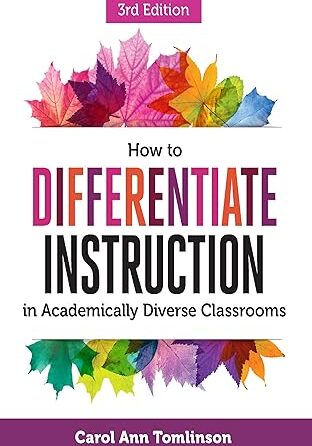Resources
Welcome to your resource hub for differentiated instruction!
Differentiated instruction is a teaching approach that recognizes that students learn at different paces and in different ways. By tailoring instruction to meet the individual needs of each student, teachers can create a more engaging and effective learning environment.
This resource section is designed to provide you with a wealth of information, strategies, and tools to help you implement differentiated instruction in your classroom. Whether you're a seasoned educator or just starting out, you'll find valuable resources here to support your teaching journey.
This section is not exhaustive but represents a few resources I have found helpful.

In this one-stop resource for middle and high school teachers, Kristina J. Doubet and Jessica A. Hockett explore how to use differentiated instruction to help students be more successful learners — regardless of background, native language, learning style, motivation, or school savvy. They explain how to
* Create a healthy classroom community in which students' unique qualities and needs are as important as the ones they have in common.
* Translate curriculum into manageable and meaningful learning goals that are fit to be differentiated.
* Use pre-assessment and formative assessment to uncover students' learning needs and tailor tasks accordingly.
* Present students with avenues to take in, process, and produce knowledge that appeal to their varied interests and learning profiles.
* Navigate roadblocks to implementing differentiation.
Each chapter provides a plethora of practical tools, templates, and strategies for a variety of subject areas developed by and for real teachers. Whether you're new to differentiated instruction or looking to expand your repertoire of DI strategies, Differentiation in Middle and High School will show you classroom-tested ways to better engage students and help them succeed every day.

We differentiate instruction to honor the reality of the students we teach. They are energetic and outgoing. They are quiet and curious. They are confident and self-doubting. They are interested in a thousand things and deeply immersed in a particular topic. They are academically advanced and “kids in the middle” and struggling due to cognitive, emotional, economic, or sociological challenges. More of them than ever speak a different language at home. They learn at different rates and in different ways. And they all come together in our academically diverse classrooms.
Written as a practical guide for teachers, this expanded third edition of Carol Ann Tomlinson’s groundbreaking work covers the fundamentals of differentiation and provides additional guidelines and new strategies for how to go about it. You’ll learn
- What differentiation is and why it’s essential
- How to set up the flexible and supportive learning environment that promotes success
- How to manage a differentiated classroom
- How to plan lessons differentiated by readiness, interest, and learning profile
- How to differentiate content, process, and products
- How to prepare students, parents, and yourself for the challenge of differentiation

Coding teaches our students the essence of logical thinking and problem solving while also preparing them for a world in which computing is becoming increasingly pervasive. While there's excitement and enthusiasm about programming becoming an intrinsic part of K-12 curricula the world over, there's also growing anxiety about preparing teachers to teach effectively at all grade levels. This book is an essential, enduring, practical guide for every K-12 teacher anywhere who is either teaching or planning to teach computer science and programming at any grade level. To this end, readers will discover:
- ❖ An A-to-Z organization that affords comprehensive insight into teaching introductory programming.
- ❖ 26 chapters that cover foundational concepts, practices and well-researched pedagogies related to teaching introductory programming as an integral part of K-12 computer science. Cumulatively these chapters address the two salient building blocks of effective teaching of introductory programming-what content to teach (concepts and practices) and how to teach (pedagogy).
- ❖ Concrete ideas and rich grade-appropriate examples inspired by practice and research for classroom use.
- ❖ Perspectives and experiences shared by educators and scholars who are actively practicing and/or examining the teaching of computer science and programming in K-12 classrooms.
Two Articles - Abstracts & Links Included
Abstract: With contemporary classrooms becoming increasingly diverse, educational authorities, teachers and school administrators are looking to teaching and learning strategies that cater for a variety of learning profiles. A paradigm that is gaining ground in many educational circles is differentiated instruction. This model proposes a rethinking of the structure, management and content of the classroom, inviting participants within the learning context to become engaged in the process, to the benefit of all. While the model has been accepted and set to work, there remains room for theoretical support to give it momentum. A recent, comprehensive analysis of the literature in this area examines this model, within the context of increasing academic diversity. This paper therefore seeks to synthesize the research supporting a shift to a new exemplar for modern education, and in so doing shed light on the rationale supporting differentiated instruction.
Abstract: Given the increasing diversity of the student body, teachers are called to appropriately address students’ various learning needs by means of differentiated instruction (DI). However, empirical research has yielded mixed evidence on teachers’ reported use of DI. Using nationally representative data from the National Educational Panel Study in Germany, this article aimed to explore German (as native language) and Mathematics teachers’ use of DI practices. In addition, this study took into consideration contextual factors, such as school track, and investigated the impact of teachers’ constructivist beliefs on their DI implementation. Results from a mixed analysis of covariance indicated that teachers occasionally implement DI practices. Furthermore, between-subject effects reported differences across school tracks. It appears that advanced secondary school teachers implement less often DI practices. The covariate of teachers’ constructivist beliefs was also positively linked to overall teachers’ implementation of DI. Implications of the results, as well as further lines of research are discussed.

